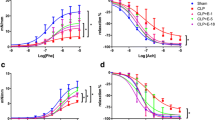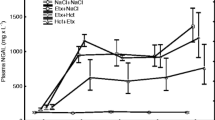Abstract
Purpose
To compare the effects of recombinant human activated protein C (APC) and glucocorticoids alone and in combination in non-anesthetized resuscitated septic shock induced by cecal ligation and puncture (CLP) on (a) survival, (b) hemodynamics, and (c) vascular reactivity. The effects of treatments on major cellular pathways likely implicated were also studied.
Methods
Four hours after CLP, rats were continuously infused with either saline (10 ml/kg/h), saline + APC, saline + dexamethasone (Dexa), or saline + APC + Dexa. Eighteen hours after CLP, arterial pressure, cardiac output, nitrite/nitrate ratio, and lactate concentrations were measured. Aortic rings and mesenteric arteries were isolated and mounted in a myograph, after which arterial contractility and endothelium-dependent relaxation were measured in the presence or absence of nitric oxide synthase (NOS) or cyclooxygenase (COX) inhibitors. Protein expression was assessed by Western blotting. Aorta NO and superoxide anion content were measured by electron paramagnetic resonance.
Results
All treatments improved hemodynamic parameters and vascular reactivity and decreased lactate and nitrite/nitrate levels.
In treated aorta and mesenteric arteries, contractility and endothelial dysfunction were improved. This effect was associated with an increase in the phosphorylated form of protein kinase B as well as an increase in COX vasodilatory pathways and a decrease in iNOS expression suggesting that these pathways are implicated in the vascular effect of the treatments. CLP was associated with a marked increase in aortic NO and superoxide anion content (p < 0.05), which were decreased by APC and Dexa and totally abolished by APC + Dexa (p < 0.01). Survival length was significantly increased by the APC–Dexa combination.
Conclusions
Both APC and Dexa improve arterial contractility and endothelial dysfunction resulting from septic shock in rats. Moreover, their combination increased the length of survival. These findings provide important insights into the mechanisms underlying APC- and/or Dexa-induced improvements of arterial dysfunction during septic shock.





Similar content being viewed by others
References
Aird WC (2004) Endothelium as an organ system. Crit Care Med 32:S271–S279
Levi M, van der Poll T (2010) Inflammation and coagulation. Crit Care Med 38:S26–S34
Dellinger RP, Levy MM, Carlet JM, Bion J, Parker MM, Jaeschke R, Reinhart K, Angus DC, Brun-Buisson C, Beale R, Calandra T, Dhainaut JF, Gerlach H, Harvey M, Marini JJ, Marshall J, Ranieri M, Ramsay G, Sevransky J, Thompson BT, Townsend S, Vender JS, Zimmerman JL, Vincent JL (2008) Surviving Sepsis Campaign: international guidelines for management of severe sepsis and septic shock: 2008. Intensive Care Med 34:17–60
Bernard GR, Vincent JL, Laterre PF, LaRosa SP, Dhainaut JF, Lopez-Rodriguez A, Steingrub JS, Garber GE, Helterbrand JD, Ely EW, Fisher CJ Jr (2001) Efficacy and safety of recombinant human activated protein C for severe sepsis. N Engl J Med 344:699–709
Mosnier LO, Zlokovic BV, Griffin JH (2007) The cytoprotective protein C pathway. Blood 109:3161–3172
Esmon CT (2006) The endothelial protein C receptor. Curr Opin Hematol 13:382–385
Joyce DE, Gelbert L, Ciaccia A, DeHoff B, Grinnell BW (2001) Gene expression profile of antithrombotic protein C defines new mechanisms modulating inflammation and apoptosis. J Biol Chem 276:11199–11203
Day NP, Phu NH, Mai NT, Bethell DB, Chau TT, Loc PP, Chuong LV, Sinh DX, Solomon T, Haywood G, Hien TT, White NJ (2000) Effects of dopamine and epinephrine infusions on renal hemodynamics in severe malaria and severe sepsis. Crit Care Med 28:1353–1362
Bilbault P, Lavaux T, Launoy A, Gaub MP, Meyer N, Oudet P, Pottecher T, Jaeger A, Schneider F (2007) Influence of drotrecogin alpha (activated) infusion on the variation of Bax/Bcl-2 and Bax/Bcl-xl ratios in circulating mononuclear cells: a cohort study in septic shock patients. Crit Care Med 35:69–75
Looney MR, Matthay MA (2006) Bench-to-bedside review: the role of activated protein C in maintaining endothelial tight junction function and its relationship to organ injury. Crit Care 10:239
Regnault V, Levy B (2007) Recombinant activated protein C in sepsis: endothelium protection or endothelium therapy? Crit Care 11:103
Favory R, Lancel S, Marechal X, Tissier S, Neviere R (2006) Cardiovascular protective role for activated protein C during endotoxemia in rats. Intensive Care Med 32:899–905
Isobe H, Okajima K, Uchiba M, Mizutani A, Harada N, Nagasaki A, Okabe K (2001) Activated protein C prevents endotoxin-induced hypotension in rats by inhibiting excessive production of nitric oxide. Circulation 104:1171–1175
Gupta A, Rhodes GJ, Berg DT, Gerlitz B, Molitoris BA, Grinnell BW (2007) Activated protein C ameliorates LPS-induced acute kidney injury and downregulates renal iNOS and angiotensin 2. Am J Physiol Renal Physiol 293:F245–F254
Monnet X, Lamia B, Anguel N, Richard C, Bonmarchand G, Teboul JL (2005) Rapid and beneficial hemodynamic effects of activated protein C in septic shock patients. Intensive Care Med 31:1573–1576
Sennoun N, Meziani F, Dessebe O, Cattan V, Collin S, Montemont C, Gibot S, Asfar P, Ramaroson A, Regnault V, Slama M, Lecompte T, Lacolley P, Levy B (2009) Activated protein C improves lipopolysaccharide-induced cardiovascular dysfunction by decreasing tissular inflammation and oxidative stress. Crit Care Med 37:246–255
Annane D, Bellissant E, Bollaert PE, Briegel J, Confalonieri M, De Gaudio R, Keh D, Kupfer Y, Oppert M, Meduri GU (2009) Corticosteroids in the treatment of severe sepsis and septic shock in adults: a systematic review. JAMA 301:2362–2375
Marik PE, Pastores SM, Annane D, Meduri GU, Sprung CL, Arlt W, Keh D, Briegel J, Beishuizen A, Dimopoulou I, Tsagarakis S, Singer M, Chrousos GP, Zaloga G, Bokhari F, Vogeser M (2008) Recommendations for the diagnosis and management of corticosteroid insufficiency in critically ill adult patients: consensus statements from an international task force by the American College of Critical Care Medicine. Crit Care Med 36:1937–1949
Hafezi-Moghadam A, Simoncini T, Yang Z, Limbourg FP, Plumier JC, Rebsamen MC, Hsieh CM, Chui DS, Thomas KL, Prorock AJ, Laubach VE, Moskowitz MA, French BA, Ley K, Liao JK (2002) Acute cardiovascular protective effects of corticosteroids are mediated by non-transcriptional activation of endothelial nitric oxide synthase. Nat Med 8:473–479
Prigent H, Maxime V, Annane D (2004) Science review: mechanisms of impaired adrenal function in sepsis and molecular actions of glucocorticoids. Crit Care 8:243–252
Mansart A, Bollaert PE, Levy B, Nicolas MB, Mallie JP (2003) Comparative effects of dexamethasone and l-canavanine in experimental septic shock. Eur J Pharmacol 475:61–67
Sennoun N, Baron-Menguy C, Burban M, Lecompte T, Andriantsitohaina R, Henrion D, Mercat A, Asfar P, Levy B, Meziani F (2009) Recombinant human activated protein C improves endotoxemia-induced endothelial dysfunction: a blood-free model in isolated mouse arteries. Am J Physiol Heart Circ Physiol 297:H277–H282
Mansart A, Bollaert PE, Seguin C, Levy B, Longrois D, Mallie JP (2003) Hemodynamic effects of early versus late glucocorticosteroid administration in experimental septic shock. Shock 19:38–44
Maybauer MO, Maybauer DM, Fraser JF, Szabo C, Westphal M, Kiss L, Horvath EM, Nakano Y, Herndon DN, Traber LD, Traber DL (2010) Recombinant human activated protein C attenuates cardiovascular and microcirculatory dysfunction in acute lung injury and septic shock. Crit Care 14:R217
Matsuda N, Hayashi Y, Takahashi Y, Hattori Y (2006) Phosphorylation of endothelial nitric-oxide synthase is diminished in mesenteric arteries from septic rabbits depending on the altered phosphatidylinositol 3-kinase/Akt pathway: reversal effect of fluvastatin therapy. J Pharmacol Exp Ther 319:1348–1354
Cauwels A (2007) Nitric oxide in shock. Kidney Int 72:557–565
Pacher P, Beckman JS, Liaudet L (2007) Nitric oxide and peroxynitrite in health and disease. Physiol Rev 87:315–424
Dudzinski DM, Michel T (2007) Life history of eNOS: partners and pathways. Cardiovasc Res 75:247–260
Levy B, Collin S, Sennoun N, Ducrocq N, Kimmoun A, Asfar P, Perez P, Meziani F (2010) Vascular hyporesponsiveness to vasopressors in septic shock: from bench to bedside. Intensive Care Med 36:2019–2029
Connelly L, Madhani M, Hobbs AJ (2005) Resistance to endotoxic shock in endothelial nitric-oxide synthase (eNOS) knock-out mice: a pro-inflammatory role for eNOS-derived no in vivo. J Biol Chem 280:10040–10046
Strunk V, Hahnenkamp K, Schneuing M, Fischer LG, Rich GF (2001) Selective iNOS inhibition prevents hypotension in septic rats while preserving endothelium-dependent vasodilation. Anesth Analg 92:681–687
Buckley JF, Singer M, Clapp LH (2006) Role of KATP channels in sepsis. Cardiovasc Res 72:220–230
Vieillard-Baron A, Prin S, Chergui K, Dubourg O, Jardin F (2003) Hemodynamic instability in sepsis: bedside assessment by Doppler echocardiography. Am J Respir Crit Care Med 168:1270–1276
Rivers E, Nguyen B, Havstad S, Ressler J, Muzzin A, Knoblich B, Peterson E, Tomlanovich M (2001) Early goal-directed therapy in the treatment of severe sepsis and septic shock. N Engl J Med 345:1368–1377
Acknowledgment
The authors thank Mr Pothier Pierre (Pierre Pothier Translation, Sherbrooke, Quebec, Canada) for his help in translating the manuscript. This work was supported by Inserm.
Conflict of interest
None of the authors declare any conflict of interest in relation to this study.
Author information
Authors and Affiliations
Corresponding author
Electronic supplementary material
Below is the link to the electronic supplementary material.
Rights and permissions
About this article
Cite this article
Bouazza, Y., Sennoun, N., Strub, C. et al. Comparative effects of recombinant human activated protein C and dexamethasone in experimental septic shock. Intensive Care Med 37, 1857–1864 (2011). https://doi.org/10.1007/s00134-011-2327-9
Received:
Accepted:
Published:
Issue Date:
DOI: https://doi.org/10.1007/s00134-011-2327-9




